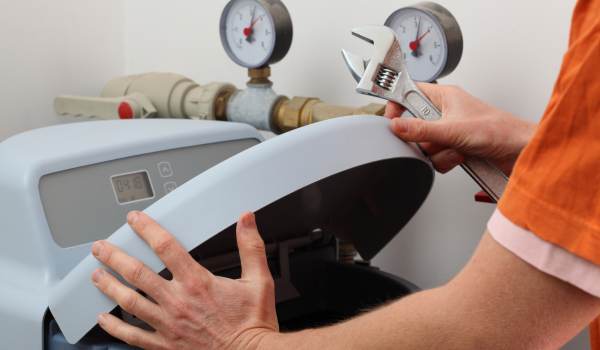If you’ve just picked up a new reverse osmosis system — congrats! 🥳 You’re just a few steps away from cleaner, better-tasting drinking water.
The good news? Installing it yourself isn’t as intimidating as it sounds.
With a few basic tools, a little patience, and this step-by-step guide, you’ll have fresh, filtered water flowing from your tap in no time.
Let’s walk through exactly how to hook it all up without the guesswork.
🧠 Quick Takeaways
- ✅ Most RO systems are designed for under-sink installation — no fancy plumbing degree required.
- ✅ Key components: pre-filters, RO membrane, storage tank, faucet, and drain line.
- ✅ Planning ahead (test-fitting parts, checking tubing lengths) saves huge headaches later.
- ✅ Special tools like a faucet drill bit might be needed if your sink doesn’t have an extra hole.
- ✅ Flushing and pressure testing are critical before that first drink!
💬 Good to Know: If you’re not comfortable drilling into sinks or stone countertops, it’s totally OK to call a pro for help with just that step.
🧪 How These Systems Work (Behind the Scenes)

Clean drinking water isn’t magic — it’s smart filtration at work.
Here’s a quick look at what’s happening behind the scenes once your reverse osmosis system is up and running.
| Component | What It Does |
|---|---|
| 🧹 Pre-Filters | Trap dirt, chlorine, and chemicals before they reach the delicate RO membrane. |
| 🧪 RO Membrane | Removes 99%+ of dissolved solids, heavy metals, and microscopic contaminants. |
| 🛡️ Post-Filters | Polish the water — removing any lingering tastes, odors, or fine particles. |
| 🛢️ Storage Tank | Holds purified water, so you always have fresh water ready when you need it. |
| 🚰 RO Faucet | Delivers clean, filtered water without tapping into your main faucet line. |
💬 Good to Know: Some newer RO systems add a “remineralization” filter after purification — putting healthy minerals like calcium back into your water for better taste and balance. Always check your model to see if that’s included!
🛠️ Planning Your Installation

Before you grab the drill, a little planning goes a long way. Reverse osmosis setups aren’t complicated — but taking a few minutes to map things out will make installation much smoother. 🧠
Here’s what you need to know before you start:
| 🔍 Step | 🛠️ What To Do |
|---|---|
| 🧹 Unpack Your System | Double-check that all parts are included — tubing, fittings, filters, storage tank, faucet, and manuals. |
| 📖 Read the Instructions | Skim your owner’s manual before beginning. Every system has slight variations you’ll want to know ahead of time. |
| 📏 Test Fit the Components | Place the RO unit, tank, and faucet in their future spots. Make sure tubing can reach without major bending or stretching. |
| 🔩 Check the Mounting Space | Make sure the cabinet wall is level and can support the system. Leave at least 16″ below the bracket for cartridge changes. |
| 🛠️ Gather Extra Tools | Grab plumber’s tape, clear caulk, drill with bits, screwdriver, wrench, and a pencil for marking holes. |
| 🚰 Prep the Sink | If there’s no existing hole for the RO faucet, you’ll need to drill one — or have a pro do it for stone countertops. |
✅ Pro Tip: If you’re drilling a new hole, measure twice and start with a small pilot bit. It’s way easier to go bigger later than fix a too-big hole! 🔩
💬 Good to Know: Most sinks already have an extra hole under a soap dispenser or sprayer — you might not even need to drill at all!
🛠️ Installation (Step-by-Step)
You’ve mapped it all out — now it’s time to make it happen! 🚀
Here’s the play-by-play to get your RO system up and running:
| 🔢 Step | 🔧 What To Do |
|---|---|
| 🚰 1. Turn Off Cold Water Supply | Locate the cold water shutoff valve under the sink and close it completely before starting. |
| 🛠️ 2. Install the RO Faucet | Mount the faucet first — seat it with a dab of caulk to prevent leaks, then secure it with washers and nuts underneath. |
| 🔩 3. Attach the Drain Saddle | Install the drain line clamp onto the sink drain — away from dishwashers or disposals to prevent backflow. |
| 🛢️ 4. Set Up the Storage Tank | Wrap the tank threads with plumber’s tape, attach the tank valve, and slide the tank into position under the sink. |
| 🛠️ 5. Mount the Filter Unit | Using a level, mount the RO filter assembly on the cabinet wall — leave at least 16″ underneath for easy maintenance. |
| 🔗 6. Connect the Tubing | Follow color-coding: Yellow = feed line, Green = tank, Black = drain, Blue = faucet. Trim tubing to avoid loops. |
| 🧪 7. Install the Cartridges | Insert all filters and the RO membrane (if needed), ensuring they’re seated properly in the housings. |
| 🔍 8. Pressure Test the System | Slowly turn the water back on. Open the RO faucet to purge air and check all fittings for leaks. |
| 💧 9. Flush and Fill the Tank | Allow the first full tank to flush out — this clears carbon dust and ensures clean drinking water moving forward. |
✅ Pro Tip: Keep a small towel or sponge handy during installation — tiny drips are common and much easier to catch early! 🧽
💬 Good to Know: Your first tank fill might take a few hours — but once pressurized, you’ll have a steady stream of purified water ready to go! 🥤
👷 When You Should Call a Pro

Most RO installs are a DIY win — but sometimes it’s smarter (and cheaper long-term) to call in help. Here’s when:
- ✅ Stone Countertops: If you need to drill a faucet hole into granite, marble, or quartz — trust a pro. One wrong move can crack a $3,000 countertop. 😬
- ✅ Complex Installations: If your RO unit needs to feed a fridge, an ice maker, or a distant sink, it gets tricky fast. Routing extra tubing or installing pumps is best left to an experienced plumber.
- ✅ Tight Spaces: If the cabinet under your sink looks more like a Tetris puzzle, a pro can fit everything perfectly (without breaking fittings or your patience).
- ✅ Unusual Plumbing Connections: Older homes sometimes have funky, non-standard pipes or weird layouts. Save yourself the headache — a plumber will know exactly which adapters and techniques to use.
💬 Good to Know: Most straightforward under-sink RO installations can be done in a morning. But if you’re dealing with anything beyond the basics, investing in a professional install can actually save you money (and prevent leaks!) down the road. 🛠️
🧼 Final Thoughts: Enjoy Crisp, Clean RO Water
Installing a reverse osmosis system takes a little patience — but the payoff is pure, great-tasting water that’s worth every ounce of effort. 🚰✨
- ✅ Remember to plan ahead, test-fit your components, and don’t rush the tubing connections.
- ✅ Reverse osmosis filters remove some of the toughest contaminants — see which filters remove the most here.
- ✅ Once you’re set up, keeping your RO system running like new is simple with this easy maintenance guide.
With a little prep (and maybe a towel for drips), you’ll have a powerful home filtration system that delivers peace of mind — and water that actually tastes as good as it should. 💧
Cheers to cleaner, safer water for years to come! 🥂
 99 people found this helpful. Was this guide helpful to you?
99 people found this helpful. Was this guide helpful to you? 


